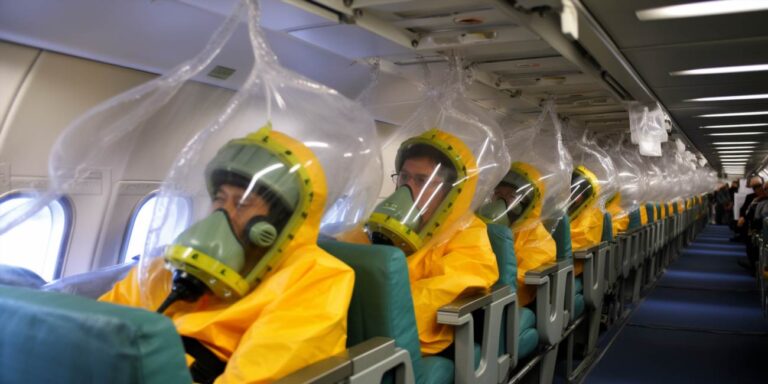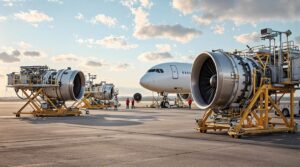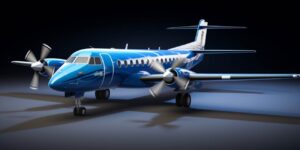Typically, aircraft are equipped with oxygen masks that automatically deploy when a drop in cabin pressure is detected. Passengers are instructed to secure their own masks before assisting others, emphasizing the importance of individual well-being in such situations. The emergency oxygen supply is designed to provide a sufficient amount of breathable air until the aircraft descends to a lower altitude where the natural air pressure is adequate.
The duration for which the emergency oxygen on aircraft lasts varies depending on several factors, including the type of aircraft and the altitude at which the incident occurs. On commercial flights, the standard emergency oxygen supply is typically designed to last approximately 12 to 15 minutes. This timeframe is calculated based on the assumption that the aircraft will descend promptly to a safer altitude within that period.
It’s crucial to note that the limited duration of the emergency oxygen supply is intentional. It is not meant for sustained use but rather as a temporary measure to ensure the well-being of passengers and crew until the aircraft can reach a lower altitude. Additionally, the finite supply helps conserve resources and allows for a controlled descent to a more oxygen-rich environment.
The following table illustrates the approximate duration of emergency oxygen on selected commercial aircraft:
| Aircraft Model | Emergency Oxygen Duration |
|---|---|
| Boeing 737 | 12 minutes |
| Airbus A320 | 15 minutes |
| Boeing 777 | 15 minutes |
These figures are approximate and may vary. Airlines and aircraft manufacturers adhere to strict safety standards, and emergency oxygen systems undergo regular inspections to ensure their reliability. Passengers are urged to familiarize themselves with the safety information provided on board, including the location of oxygen masks and the proper way to secure them in an emergency.
Spare oxygen cylinders in the passenger cabin: how much oxygen is available for travelers
When it comes to air travel, safety is paramount, and one crucial aspect is the provision of spare oxygen cylinders in the passenger cabin. Understanding how much oxygen is available for travelers is essential for both passengers and airline staff.
Each aircraft is equipped with an emergency oxygen system to ensure the well-being of passengers in the event of depressurization. This system typically consists of individual oxygen masks that drop down from the overhead compartments in case of an emergency. The oxygen masks are connected to oxygen cylinders stored on board.
Now, let’s delve into the specifics of how much oxygen is available for travelers. The oxygen flow to each mask is regulated to provide an adequate supply for the duration needed. Generally, the standard flow rate is sufficient to sustain a person for approximately 15 minutes.
It’s important to note that this 15-minute supply is intended to cover the time it takes for the aircraft to descend to a safe altitude where passengers can breathe comfortably without supplemental oxygen. In most cases, this is enough time for the pilot to initiate a descent and reach a lower altitude.
However, for longer-duration flights, airlines take additional precautions. Some aircraft are equipped with built-in oxygen systems that can provide a more extended supply if needed. These systems may have the capacity to deliver oxygen for up to 30 minutes or more, offering an extra layer of safety.
Now, let’s break down the key points about spare oxygen cylinders in the passenger cabin:
- The emergency oxygen system includes individual masks connected to onboard cylinders.
- The standard flow rate is designed to last for approximately 15 minutes.
- This duration is sufficient for the aircraft to descend to a safe altitude.
- Some aircraft have extended oxygen systems for longer flights, providing a supply for 30 minutes or more.
Emergency oxygen cylinders for the crew: what oxygen supply do pilots and flight attendants have?
Emergency situations in aviation demand meticulous planning and preparedness, and one critical aspect of this readiness involves pilots and flight attendants having access to reliable emergency oxygen cylinders. These cylinders play a pivotal role in ensuring crew safety during unforeseen circumstances such as rapid decompression or smoke in the cockpit.
Aviation regulations mandate that every commercial aircraft is equipped with a sufficient number of emergency oxygen cylinders to cater to the entire crew on board. The primary purpose of these cylinders is to provide a breathable supply of oxygen to the flight deck and cabin crew in the event of an emergency. Understanding the specifics of the oxygen supply available to the pilots and flight attendants is crucial for comprehending the safety measures in place.
Pilots are typically equipped with emergency oxygen masks that are easily accessible in the cockpit. These masks are designed to provide a secure seal around the pilot’s face, ensuring a continuous supply of oxygen during an emergency descent or other critical phases of flight. The pilots can quickly don these masks to maintain their cognitive functions and control over the aircraft in the event of a sudden loss of cabin pressure.
Flight attendants, on the other hand, have a different set of considerations when it comes to emergency oxygen. While some aircraft may have oxygen bottles stored in dedicated compartments, others may utilize passenger oxygen masks that can be deployed manually by the flight attendants in case of an emergency. The goal is to ensure that every member of the crew has access to a sufficient oxygen supply to carry out their responsibilities safely.
Understanding the aviation regulations surrounding emergency oxygen is essential for both pilots and flight attendants. These regulations dictate the minimum requirements for the number of oxygen cylinders on board, maintenance protocols, and testing procedures to guarantee the functionality of the emergency systems. Compliance with these regulations is not just a legal requirement but a fundamental aspect of ensuring crew safety and the overall integrity of the aircraft.
In terms of emergency procedures, both pilots and flight attendants undergo rigorous training to handle various scenarios that may require the use of emergency oxygen. This training includes proper donning of oxygen masks, communication protocols, and coordination between the flight deck and cabin crew to manage the situation effectively. The ability to execute these emergency procedures swiftly and accurately is paramount for the safety of everyone on board.
As we delve into the intricate details of emergency oxygen provisions for aviation crews, it becomes evident that meticulous planning, adherence to regulations, and rigorous training are the cornerstones of ensuring crew safety in the face of unforeseen challenges.
Tests and studies on oxygen supplies on board passenger aircraft
Recent scientific research has delved into the intricacies of ensuring optimal oxygen supplies on board passenger aircraft, a critical aspect in maintaining passenger safety and well-being. Aviation institutes play a pivotal role in this domain, earning certificates of compliance by adhering to stringent FAA regulations.
Understanding the complexities of oxygen delivery systems is crucial in the aviation industry. The FAA regulations mandate that aircraft must be equipped with reliable and efficient oxygen supplies to address potential emergencies. This requirement is not just a formality; it stems from a comprehensive body of scientific research that evaluates the physiological effects of varying oxygen levels at different altitudes.
Aviation institutes, responsible for training the next generation of aviation professionals, must ensure that their programs align with the latest FAA regulations. The emphasis on certificates of compliance underscores the commitment to maintaining the highest standards in aviation safety. Students graduating from these institutes are not just equipped with theoretical knowledge but are instilled with a deep understanding of the practical implications of scientific research in aviation.
The dynamic nature of aviation technology requires a continuous cycle of scientific research to stay abreast of advancements. This includes studies on the most efficient oxygen supplies that can be integrated into aircraft systems. The goal is not just compliance with FAA regulations, but a proactive approach to enhance safety measures based on the latest findings in scientific research.
One interesting aspect is the collaborative efforts between aviation institutes and industry stakeholders. These collaborations often result in innovative solutions that go beyond the minimum requirements set by FAA regulations. The synergy between academia and industry contributes significantly to the evolution of scientific research in aviation, leading to advancements in oxygen supplies and other critical safety components.
Examining the landscape of aviation institutes, it becomes evident that certificates of compliance are not just documents; they represent a commitment to excellence in education and safety. These certificates validate that the institute’s curriculum and practices align with the rigorous standards set by the FAA regulations.






